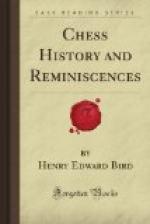Note. The Throne, Cartouche, Signet, and other relics. The Draught Box and Draughtsmen of Queen Hatasu in the Manchester Exhibition 1887. Date B.C. 1600. The catalogue says: These remarkable relics, the workmanship of royal artists 3,500 years ago, i.e., 200 years before the birth of Moses, are now being exhibited for the first time, by the kind permission of their owner, Jesse Haworth, Esq. Queen Hatasu was the favourite daughter of Thotmes I, and the sister of Thotmes ii and III, Egyptian Kings of the XVIII dynasty. She reigned conjointly with her eldest brother, then alone for 15 years, and for a short time with her younger brother, Thotmes III. She was the Elizabeth of Egyptian history: had a masculine genius and unbounded ambition. A woman, she assumed male attire; was addressed as a king even in the inscriptions upon her monument. Her edifices are said to be “the most tasteful, most complete and brilliant creations which ever left the hands of an Egyptian architect.” The largest and most beautifully executed obelisk; still standing at Karnak, bears her name. On the walls of her unique and beautiful temple at Dayr el Baharee, we see a naval expedition sent to explore the unknown land of Punt, the Somali country on the East coast of Africa near Cape Guardafui 600 years before the fleets of Solomon, and returning laden with foreign woods, rare trees, gums, perfumes and strange beasts. Here we have 1. Queen Hatasu’s throne, made of wood foreign to Egypt, the legs most elegantly carved in imitation of the legs of an animal, covered with gold down to the hoof, finishing with a silver band. Each leg has carved in relief two Uroei, the sacred cobra serpent of Egypt, symbolic of a goddess. These are plated with gold. Each arm is ornamented with a serpent curving gracefully along from head to tail, the scales admirably imitated by hundreds of inlaid silver rings. The only remaining rail is plated with silver. The gold and silver are of the purest quality.
2. A fragment of the Cartouche or oval bearing the royal name, and once attached to the Throne; the hieroglyphics are very elegantly carved in relief, with a scroll pattern round the edge, and around one margin, and a palm frond pattern around the other. About one fourth of the oval remains, by means of which our distinguished Egyptologist, Miss Amelia B. Edwards, L.L.D., has been able to complete the name and identify the throne. On one side is the great Queen’s throne name, Ru-ma-ka. On the other the family name, Amen Knum Hat Shepsu, commonly read Hatasu. With all its imperfections it is unique, being the only throne which has ever been disinterred in Egypt.
3. A female face boldy, but exquisitely carved in dark wood, from the lid of a coffin, the effigy strongly resembling the face of the sitting statue of Hatasu in the Berlin Museum: the eyes and double crown are lost.
4. The Signet: This is a Scarabaeus, in turquoise bearing the Cartouche of Queen Hatasu, once worn as a ring.




